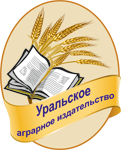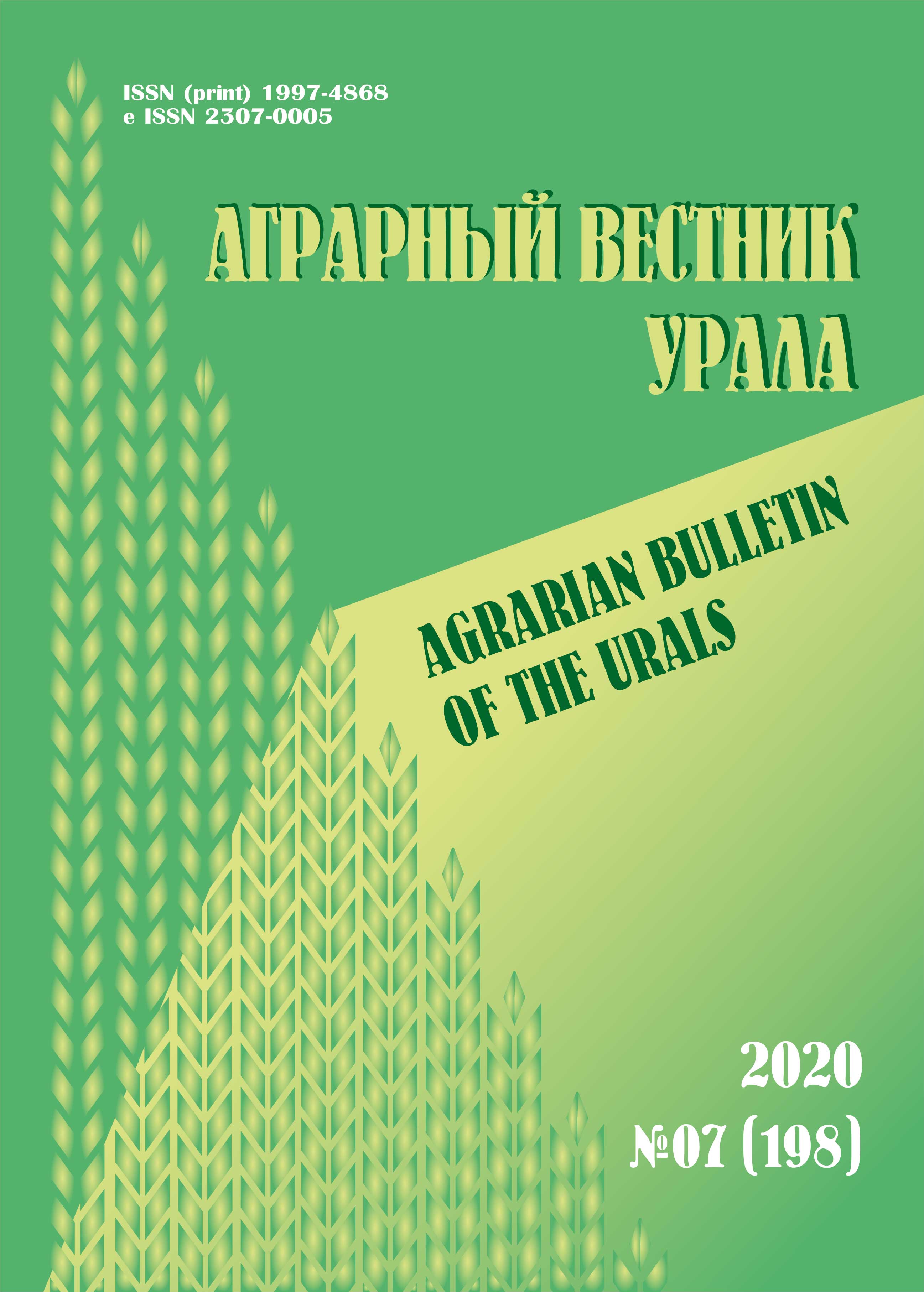Russian Federation
Abstract. The aim of the study is to predict the level of damage to the root system of spring soft wheat by fusarium infection in the conditions of the Kirov region and to identify promising disease-resistant lines. Methods. The object of research was 146 lines of spring soft wheat of the FARC of the North-East selection, which were sown annually against an infections background of fusarium root rot. Results. As a result of many years of research (2004-2006 u 2009˗2020) it was found that a high level of infection of plants of spring soft wheat by root rot was observed in years with an average daily air temperature in the first decade of July in the range from 15 to 23 °C and precipitation in the first decade of august of 30 or more millimeters. A rectilinear regression equation was obtained that reflects the quantitative variability of the disease development indicator from the total year of the weather index. A retrospective analysis of the expected (according to the forecast) and actual development of fusarium root rot on spring wheat showed a fairly high level of coincidence of the date obtained (67 %). Among the promising spring soft wheat lines of the FARC of the North-East selection, 3 (E-310, U-163 and T-79) with resistance to root rot were identified. Combining high resistance to the fusarium root rot and the yield of significantly higher than the standards, the breeding line E-310 can be recommended for transfer to variety testing. The selected highly and moderately resistant lines can be used in further breeding as sources of resistance to the disease. The decrease in grain weight from 1 m2 in susceptible lines compared to resistant ones was on average 83.4 g. The degree of development of the disease in plants affected the yield and weight of grain to a greater extent (d = 15.3 and 11.0 % respectively). In midseason lines the damage and development of root rot was 77.5 and 82.9 % respectively, determined by the duration of the “stands – heading” period. In early maturing lines showed a positive significant correlation between the duration of the “stands – heading” period and the development of root rot (r = +0.66).
root rot, meteopathological forecast, spring soft wheat, development of the disease, sources of resistance
1. Vasil'eva N. V., Sineschekov V. E. Prichiny usileniya rasprostraneniya kornevyh gniley vshodov yarovoy pshenicy v lesostepi Priob'ya // Vestnik NGAU (Novosibirskiy gosudarstvennyy agrarnyy universitet). 2017. № 4. S. 13-18.
2. Toropova E. Yu., Sokolov M. S. Rol' sorta v kontrole obyknovennoy kornevoy gnili yarovoy pshenicy // Agrohimiya. 2018. № 11. S. 48-59. DOI:https://doi.org/10.1134/S0002188118110108. EDN: https://elibrary.ru/YNTORV
3. Schekleina L. M., Sheshegova T. K. Belokolosost' na sortah ozimoy rzhi v agroekologicheskih usloviyah Kirovskoy oblasti // Agrarnyy vestnik Urala. 2020. № 2 (193). S. 27-36. DOI:https://doi.org/10.32417/1997-4868-2020-193-2-27-36. EDN: https://elibrary.ru/UHRAFP
4. Snigireva O. M., Vedernikov Yu. E. Razvitie bolezney yarovoy pshenicy sorta Bazhenka pri primenenii regulyatorov rosta v usloviyah Kirovskoy oblasti // Permskiy agrarnyy vestnik. 2020. № 2 (30). S. 72-80. DOI:https://doi.org/10.24411/2307-2873-2020-10024. EDN: https://elibrary.ru/QBCYNE
5. Kincharova M. N., Kincharov A. I. Izuchenie rasprostranennosti mikoflory na semenah yarovoy pshenicy v usloviyah Samarskoy oblasti // Agrarnyy nauchnyy zhurnal. 2021. № 3. S. 25-29. DOI:https://doi.org/10.28983/asj.y2021i3pp25-29. EDN: https://elibrary.ru/HTWWYG
6. Schekleina L. M., Ryzhenkov E. V., Sheshegova T. K. Ustoychivye k fuzarioznym kornevym gnilyam sorta yarovoy pshenicy i ozimoy rzhi // Metody i tehnologii v selekcii rasteniy i rastenievodstve: sbornik nauchnyh trudov. Kirov, 2020. C. 267-271. EDN: https://elibrary.ru/NUIOKZ
7. Evseev V. V., Porsev I. N., Malinnikov A. A., Subbotin I. A., Isaenko V. A. Kornevye gnili yarovoy pshenicy v usloviyah regional'nyh agrotehnologiy // Vestnik Kurganskogo gosudarstvennogo universiteta. 2017. № 4 (47). S. 33-37.
8. Timoshenkova T. A. Donory ustoychivosti k boleznyam yachmenya i tverdoy pshenicy dlya selekcii v stepnoy zone Orenburgskogo Predural'ya // Zhivotnovodstvo i kormoproizvodstvo. 2017. № 4 (100). S. 234-239. EDN: https://elibrary.ru/TARGWA
9. Batalova G. A. Selekciya zernovyh kul'tur na immunitet na Severo-Vostoke Evropeyskoy territorii Rossii // Zernovoe hozyaystvo Rossii. 2017. № 3 (51). S. 8-11. EDN: https://elibrary.ru/YTBERT
10. Porsev I. N., Toropova E. Yu., Isaenko V. A., Malinnikov A. A., Subbotin I. A. Kornevye gnili yarovoy pshenicy v Zaural'e i mery bor'by s nimi // APK Rossii. 2017. T. 24. № 1. S. 212-219. EDN: https://elibrary.ru/YKDPDT
11. Razina A. A., Sultanov F. S., Dyatlova O. G. Novye sorta yarovoy pshenicy i kornevaya gnil' // Vestnik KrasGAU. 2019. № 5 (146). S. 22-26. EDN: https://elibrary.ru/QICQLZ
12. Eastburn D. M., McElroneb L. J., Bilgin D. D. Influence of atmospheric and climatic change on plant-pathogen interactions // Plant Pathology. 2011. No. 60. Pp. 54-69. DOI: https://doi.org/10.1111/j.1365-3059.2010.02402.x; EDN: https://elibrary.ru/OAOUFL
13. Savchenko N. E., Aseeva T. A. Vliyanie okruzhayuschey sredy na urozhaynost' i porazhaemost' zabolevaniyami yarovoy pshenicy // Dostizheniya nauki i tehniki APK. 2019. T. 33. № 4. S. 60-63. DOI: 1024411/0235-2451-2019-10415. DOI: https://doi.org/10.24411/0235-2451-2019-10415; EDN: https://elibrary.ru/MIFUXU
14. Glinushkin A. P., Toropova E. Yu., Kazakova O. A., Ovsyankina A. V., Selyuk M. P. Razvitie pochvennyh infekciy u yarovoy pshenicy i yachmenya pod vliyaniem gidrotermicheskih stressov v usloviyah lesostepi Zapadnoy Sibiri i Zaural'ya // Rossiyskaya sel'skohozyaystvennaya nauka. 2018. № 2. S. 25-29. EDN: https://elibrary.ru/WGXAPB
15. Harina A. V. Prognoz porazheniya yarovoy myagkoy pshenicy pyl'noy golovney // Agrarnaya nauka Evro-Severo-Vostoka. 2014. № 3 (40). S. 8-11. EDN: https://elibrary.ru/SCJKOL
16. Grigor'ev M. F. Metodicheskie ukazaniya po izucheniyu ustoychivosti zernovyh kul'tur k kornevym gnilyam. Leningrad, 1976. 60 s.
17. Benken A. A., Hrustovskaya V. N. Laboratornaya ocenka bolezneustoychivyh rasteniy i paraziticheskih svoystv vozbuditeley obyknovennoy kornevoy gnili zlakov // Trudy Vserossiyskogo Instituta Zaschity Rasteniy. 1977. S. 9-13.
18. Sheshegova T. K., Kedrova L. I. Metodicheskie rekomendacii po sozdaniyu iskusstvennyh infekcionnyh fonov i ocenke ozimoy rzhi na ustoychivost' k fuzarioznym boleznyam. Kirov: NIISH Severo-Vostoka, 2003. 30 s.
19. Stepanov K. M., Chumakov A. E. Prognoz bolezney sel'skohozyaystvennyh rasteniy. Leningrad, 1972. 270 s.









